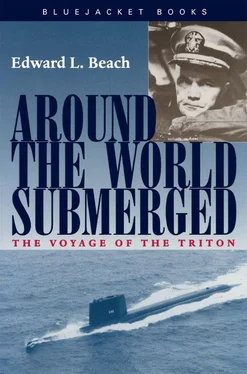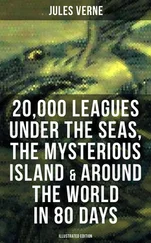Without too much fact on which to base my supposition, I have always assumed that John Eichmann had been slated for transfer to his own command, possibly to be brought back to the States for a new construction submarine as was the custom for people who had spent a long time in the war zone [and later happened, in time, to me], and that he had either been pursuaded to remain for one additional patrol, or very likely had volunteered to do so in order to provide some kind of continuity for the new skipper.
I had met Eichmann in 1939 when, as an Ensign, I spent a day at sea with the S-25 to which he was attached. Without conscious intention I had kept track of his whereabouts ever since. A year after the loss of Triton, after I had been Executive Officer of the Trigger for some time, I also agreed to stay for one extra patrol because Trigger had unexpectedly received a new skipper. In my case, Trigger survived the most serious depth-charging of her career and returned triumphantly to Pearl Harbor. But all during the ordeal, I kept hearing the parting words of the chap who left Trigger in my place: “You’ll be sorry you didn’t go, Ned—you’ll be sorry—you’ll be sorry.” The Japanese depth charges’ “click—WHAM—swish” said the same, and I kept thinking of Jack Eichmann.
Lt. McDonald and I put considerable thought into preparation of the service. We decided that a version of the committal service would be most appropriate, although we could find no reference or description of exactly what we wanted. Improvisation is the order of the day in submarines at sea anyway.
The services were announced at 1340, with directions that all hands not on watch assemble in the crew’s mess, the air-control center or the officer’s wardroom. At 1345 the services were broadcast throughout the ship, begun by the playing of Tattoo. This was followed by the National Anthem and a scripture reading from Psalm 107.
Following the scripture reading, a short prayer similar to the committal service was read, followed by reading of the tribute, which could hardly be called a eulogy but which was an attempt to put the significance of the occasion into words for our own better inspiration and understanding: The sacrifice made by the first Triton, and all the sacrifices by all the people lost in all the wars of our country, sanctify the service of those who follow in their footsteps.
Rendering of proper honors gave considerable occasion for thought, and it finally was decided that the only salute a submarine can fire is actually the most appropriate one anyway. Upon command, Triton’s course was changed to due south and the Officer of the Deck was directed to stop all engines. The entire ship’s company was then brought to attention, and all were directed to face forward. This was, of course, possible even at their regular watch stations. Then, with the entire crew silently at attention, the forward torpedo tubes were fired three times in rapid succession.
We could hear the resounding echo of the water-ram and feel the fluctuation of air pressure on our eardrums. Three times the harsh war-like note traveled through the ship; and as the last air fluctuation died away, the clear notes of Taps sounded in proud and thoughtful tribute.
The moment of reverence was a real one, truly caught. Everyone on board felt it; and though their response was by command, their personal participation sprang from deep within themselves and was given willingly.
When the memorial services were completed, we resumed our base course and speed. Next day, we were to pass between Guam and Rota islands in the Marianas.
12

During the trip across the Pacific, Triton employed two sets of navigators. The regular team, consisting of Executive Officer Will Adams and Chief Quartermaster William J. Marshall, was backed up by team number two: Operations Officer Bob Bulmer and First Class Quartermaster Curtis K. Beacham. Will, I hoped, would soon have his own command, while Bob was preparing for a chance at nuclear training. We would be bound to lose one of the two officers and possibly one of the quartermasters besides. It was just as well to be ready to make a shift in assignment.
As a consequence, the landfall on Guam was made by the combined efforts of both navigating teams, and at 0726, on the twenty-eighth of March, with the whole day ahead of us for a careful reconnaissance of this once-beleaguered Pacific bastion, Triton came to periscope depth. Guam was dead ahead and Rota lay due north. It was another perfect landfall after sixty-seven hundred miles of submerged travel.
We planned to work our photographic reconnaissance for the northwestern coast of Guam as closely as we could. We would have no problem with the three-mile limit, for Guam was a US possession. Nevertheless, so far as we knew, none of the American authorities on Guam were aware of Triton’ s trip, and from our point of view it would be as embarrassing to be detected by our own personnel as by any other nationality.
We had two complete photographic teams. Team One consisted of Commander Joseph Roberts, USNR, helped by Photographer’s Mate First Class Earnest R. Meadows, who were specially attached to Triton for the voyage. Team Two consisted of Lieutenant Dick Harris and Chief William R. Hadley. Though the teams naturally competed with each other, both had full access to the special skills and techniques which Joe Roberts had developed during a lifetime in the business. In addition to everything else, Joe had been assigned as “pool press photographer,” which meant that all his pictures would be equally available to the entire newspaper and magazine media of the country.
As the water shoaled, while we were working into position, we had an opportunity to test our latest, do-it-yourself fathometer in relatively shallow water. By this time we had two homemade fathometer heads, or transducers as they are technically called. One had been built from scratch and very neatly finished off by Phil Kinnie and Chief Engineman Alfred Abel, both of them accomplished stainless-steel welders—which is, by the way, one of the most difficult phases of the welder’s art. Commandeering one of Jim Stark’s stainless-steel medical containers, they had cut it down and welded it around the entire jury-transducer which Electronics Technician’s Mates Docker, Simpson, and Blaede had manufactured under “Whitey” Rubb’s direction; it looked like a most professional job. The second transducer was a conversion from one of our regular announcing-system speakers, waterproofed as well as we were able. While not so rugged as the stainless-steel one just described, it had the theoretical advantage of being superior in frequency response.
But as ingenious as the new heads were, they still could not transmit a signal with enough strength to pierce the outer hull and return to the ship. Our efforts, again, were a complete failure.
However, there was one way, short of cutting a hole through the bottom of the hull of the ship, to project our transducer directly into the sea and by-pass the rugged steel plating. This was through our garbage ejector. If we could operate it with the inner door closed and the outer door open, the signal would at least have an unimpeded path through water. Whether we would be able to hear an answering echo on our sonar receivers, which were located quite some distance forward of the garbage ejector, was a matter for conjecture. And whether we could devise some means of getting electrical energy into the transducer through the closed breech of the garbage ejector was a technical hurdle as yet uncrossed. But the idea was at least worth a try.
Читать дальше













